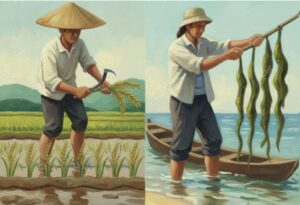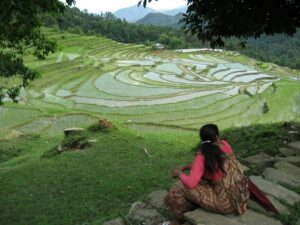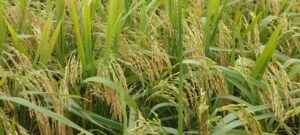by Sharif Ahmed, Manik Debnath, Bushra Humaira Sadaf, and Humnath Bhandari

In the face of rising sea levels, increased salinity, and unpredictable rainfall, coastal farmers in Bangladesh are experiencing some of the harshest impacts of climate change. Traditional farming methods struggle to cope with these changing environmental conditions, leaving many farmers vulnerable to poor yields and food insecurity. However, sorjan farming, an innovative agricultural technique, is emerging as a sustainable solution, helping farmers adapt and thrive in these challenging situations.
The Challenges Facing Coastal Agriculture
Bangladesh’s southern coastal areas are particularly prone to climate stress. During the wet season, excessive rainfall leads to frequent flooding, while in the dry season, saline water makes the soil unsuitable for most crops. As a result, farmers often face poor yields or are restricted to growing only one or two low-value crops each year. Without new farming methods, these communities are left vulnerable to worsening climate impacts.
How Sorjan Farming Works
Sorjan farming offers a practical, climate-smart approach. It involves constructing alternating raised beds and deep sinks on farmland. The raised beds are used for growing crops, while the deep sinks can be used to manage water and raise fish during both the wet and dry seasons. The Sorjan technique tackles various challenges faced by farmers in coastal areas. It helps prevent soil salinity issues and protects crops from flood damage and waterlogged roots during the monsoon season.
This is achieved by elevating plants above flood levels and storing irrigation water in the channels between the beds during the dry winter months. Its versatile advantages and effective water management make sorjan farming an excellent example of climate-smart agriculture in coastal Bangladesh.
Key Benefits of Sorjan Farming
- Year-Round Food Production
The raised beds and furrows make it possible to cultivate crops and farm fish throughout the year. Even during monsoon season, when fields would normally be waterlogged, crops can be grown on the raised beds. This ensures a steady supply of food and income for farmers. - Increased Income and Food Security
By integrating crop and fish production, sorjan farming boosts farmers’ productivity and incomes. Unlike traditional methods that often yield only one or two crops a year, this system allows continuous harvests of vegetables, fruits, and fish, helping reduce poverty and increase food security in coastal areas. - Climate Resilience
Sorjan farming is inherently climate-resilient. It addresses both flooding and soil salinity—two of the biggest challenges in coastal agriculture. The raised beds protect crops from being submerged during heavy rains, while the furrows help manage water during dry periods, reducing the reliance on unpredictable weather patterns. - Better Water and Soil Management and Flexibility
The alternating beds and furrows optimize the use of water and soil. During the dry season, stored water from the furrows can be used for irrigation, while the raised beds prevent soil salinity from damaging crops. This ensures a healthier growing environment for plants and helps farmers use limited resources more efficiently. Traditional practices often require crops to be planted in specific seasons, restricting farmers. In contrast, the sorjan system allows for more flexible planting schedules, enabling farmers to sow and harvest crops based on market demand and climate conditions. - Environmental Sustainability
The biodiversity promoted by sorjan farming enhances soil health and pest resilience. By growing different crops simultaneously, farmers create a more balanced ecosystem that supports long-term sustainability. The system also contributes to carbon sequestration, as the variety of crops and organic matter improve soil structure.
Challenges to Adoption
Despite its benefits, there are barriers to the widespread adoption of sorjan farming. Initial setup costs for constructing the raised beds and furrows can be high, which is a challenge for smallholder farmers with limited resources. Additionally, lack of awareness and training can hinder adoption. Many farmers are unfamiliar with this technique and need access to training and support to implement it successfully. Furthermore, the labor-intensive maintenance required for the beds and furrows can be a challenge, especially in regions where labor shortages are common.
However, with proper investment from government agencies, NGOs, and other stakeholders, these challenges can be addressed, allowing more farmers to benefit from this innovative practice.
Adoption In Bangladesh
The adoption of the sorjan farming system in Bangladesh has been growing, particularly in coastal areas affected by saline intrusion and flooding. However, uptake varies across regions, with some areas embracing the system more quickly than others.
Support from government agencies like Department of Agriculutral Extension (DAE) and Bangladesh Agricultural Research Institute (BARI), along with NGOs such as BRAC, have been instrumental in promoting sorjan farming through trainings, workshops, and financial assistance. In some regions, community-based approaches are being used, where farmers collaborate to share resources and reduce costs. Despite these efforts, research on sorjan farming remains limited, highlighting the need for further studies to optimize its implementation and scalability.
A Climate-Smart Future for Coastal Farmers
As Bangladesh continues to face the impacts of climate change, adopting innovative farming techniques like sorjan farming is essential. By enabling farmers to grow crops year-round, manage water more efficiently, and protect against soil salinity, sorjan farming offers a promising pathway to climate resilience in the country’s vulnerable coastal regions.
For Bangladesh’s coastal farmers, sorjan farming represents more than just an agricultural technique—it is a lifeline that supports their livelihoods, strengthens their resilience to climate change, and ensures food security for future generations.
The Sustainable Intensification of Mixed Farming Systems Initiative aims to provide equitable, transformative pathways for improved livelihoods of actors in mixed farming systems through sustainable intensification within target agroecologies and socio-economic settings.






